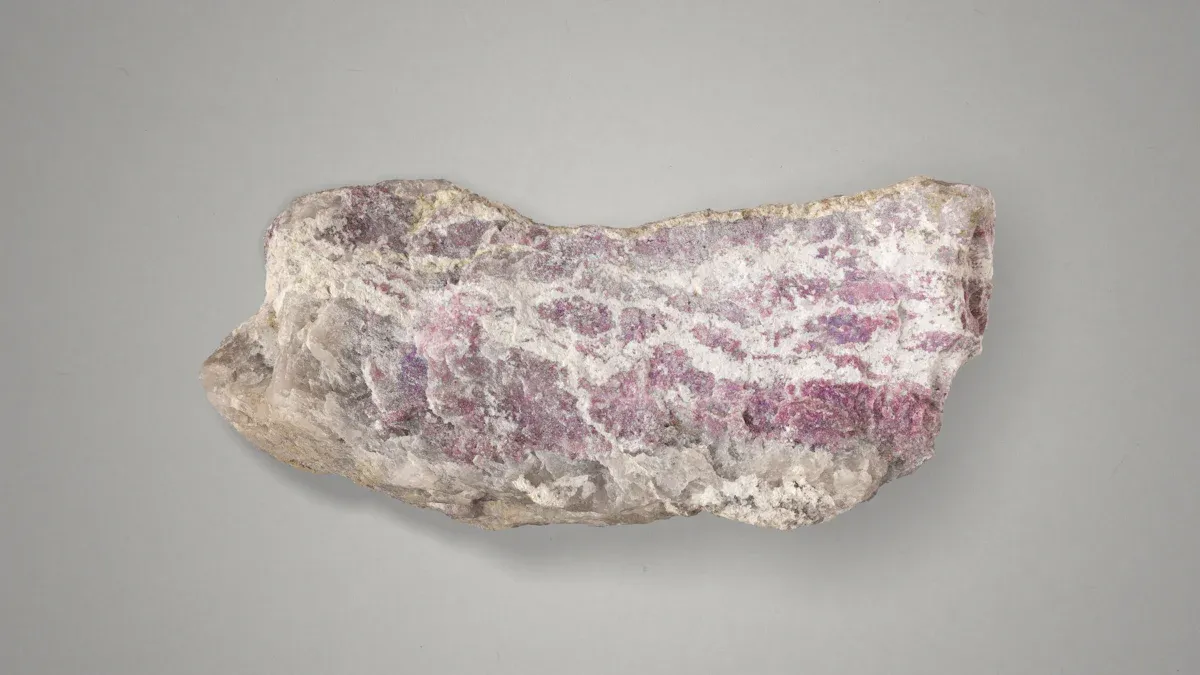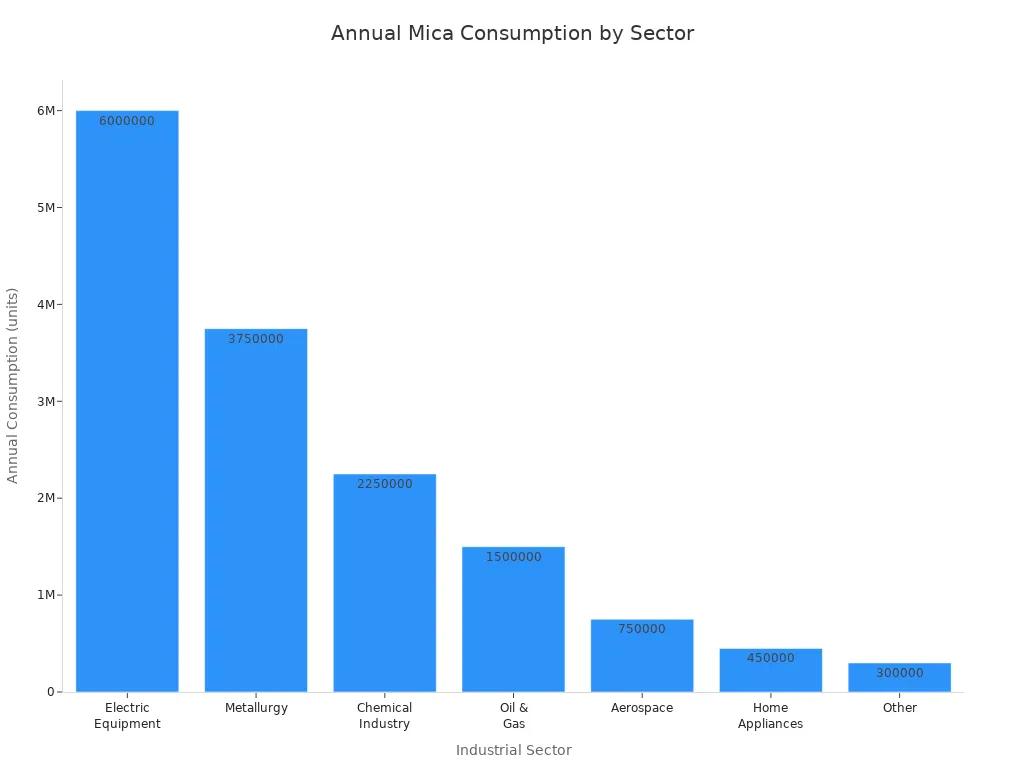







Mica is a group of minerals found in nature. These minerals are silicates. They form thin and bendy sheets. People often wonder, what is mica? Mica is easy to spot because it shines. It can handle heat well. It is also very flexible. Many things use mica, like electronics and makeup. What is mica? It is important in products that need to last and look shiny. Mica meaning is about being a mineral that is both useful and pretty. The mica stone meaning comes from its layers and bright shine. What is mica? It is also worth a lot of money, especially in muscovite mica substrates.
Mica is a mineral found in nature. It forms thin sheets that bend easily. Mica shines and looks bright. This makes it useful and nice to look at.
There are different types of mica. Muscovite and phlogopite are two examples. They have their own colors and can handle heat. This helps them fit many uses in factories and makeup.
Mica is a strong electrical insulator. It also protects against heat. It helps keep many home and electronic devices safe. It also helps them work well.
Factories use mica in paint, electronics, and makeup. Mica adds strength, shine, and safety to these products.
Mining mica can hurt the environment and people. Because of this, safer options like synthetic mica are now more common.
Mica is part of a group of minerals with layers. There are 37 different minerals in this group. They all look alike, but each has its own color and chemicals. People ask, what is mica? It is a silicate mineral that forms in thin sheets. Some common types are muscovite, biotite, phlogopite, and lepidolite. Each type has its own uses, but all can split into thin, bendy sheets.
Mica minerals grow in the monoclinic crystal system. Their shape looks like a pile of thin sheets. Each sheet has two silica tetrahedron layers and one octahedral layer. This is called a TOT-c structure. The layers stick together with big cations like potassium. These weak bonds let the sheets slide apart. That is why mica splits easily and stays flexible. The pseudohexagonal symmetry gives mica its shiny, flaky look. This structure helps answer, what is mica? It is a mineral that bends and peels into thin pieces.
Did you know? Mica's layers make it a strong electrical insulator. This is why many industries use it.
Mica is different from other minerals because of its special traits. These features make mica useful in many things.
It splits into thin, bendy sheets. This is called perfect basal cleavage.
It shines with a pearly or bright luster.
Its hardness is between 2.5 and 4 on the Mohs scale.
It comes in many colors, depending on the type. Muscovite can be colorless or greenish. Biotite is often black or brown.
Some types change color when you look at them from different sides.
Its specific gravity is between 2.76 and 3.2.
It forms thick "books" of layers, sometimes very big.
Property | Description / Examples |
|---|---|
Chemical Composition | Muscovite: KAl2(AlSi3O10)(OH)2; Biotite: K(Mg,Fe)3(AlSi3O10)(OH)2 |
Cleavage | Perfect basal cleavage, splits into thin sheets |
Crystal System | Monoclinic, pseudohexagonal symmetry |
Hardness | 2.5 to 4 |
Luster | Vitreous to pearly |
Color Variations | Muscovite: colorless to light brown; Biotite: black to dark green |
Physical Form | Layered "books" of sheets |
Mica is a strong electrical insulator with high dielectric strength. It can handle heat and chemicals, so it lasts in tough places. Its insulation keeps devices safe from heat and electricity. Mica's shine also makes it good for products that need to look bright. The answer to what is mica? includes its job as a top thermal and electrical insulator. These traits make mica special and very valuable.

Mica has a few main types. Each type looks different and is used for different things. People want to know, where is mica found? Mica is in many rocks around the world. The most common types are muscovite, biotite, phlogopite, lepidolite, and fuchsite. These are all part of the silicate mineral group that forms in nature.
Mica Type | Chemical Composition / Formula | Notes |
|---|---|---|
Muscovite | KAl2(AlSi3O10)(F, OH)2 | Clear, flexible sheets; main commercial mica. |
Biotite | K(Mg,Fe)3(AlSi3O10)(OH)2 | Black mica; found in igneous rocks. |
Phlogopite | Potassium magnesium aluminum silicate hydroxide | Amber or brown; mined from pegmatites. |
Lepidolite | K2(Li,Al)5-6(Si6-7Al2-1O20)(OH,F)4 | Pink or purple; source of lithium. |
Fuchsite | Chromium-rich mica | Green; used in mica in jewelry and decoration. |
Note: Muscovite and phlogopite are the main types used in industry. Biotite and lepidolite are also found in nature a lot.
Each mica type has its own special properties. Muscovite is clear or white. It bends easily and is good for electrical insulation. Phlogopite is amber or brown. It can take more heat than muscovite, so it is used for high heat jobs. Biotite is black or dark brown. It does not insulate as well as muscovite or phlogopite. Lepidolite is pink or purple. It has lithium, so it is important for batteries and some ceramics. Fuchsite is green and is often used in jewelry.
Mica Type | Color | Temp. Resistance | Main Use |
|---|---|---|---|
Muscovite | Clear, White | Up to 500°C | Electrical insulators, capacitors |
Phlogopite | Amber, Brown | Up to 900°C | High-temp insulators, foundry uses |
Biotite | Black, Brown | Moderate | Geology, some insulators |
Lepidolite | Pink, Purple | Moderate | Lithium extraction, ceramics |
Fuchsite | Green | Moderate | Jewelry, decoration |
Muscovite is known for being strong and bendy. Phlogopite is better with heat, so it is used where things get very hot. Biotite and lepidolite have their own uses, but they are not as good as muscovite or phlogopite for heat or electricity. Fuchsite is liked for its green color and is used for decoration. These differences help people pick the right mica for each use.
Mica is found in many things at home. It helps these things work better and last longer. You can find mica in irons, toasters, heaters, and hairdryers. It works as an insulator. This keeps heat and electricity in the right place. That makes these devices safer and helps them use less energy. Mica insulation wraps around heating parts in kettles and rice cookers. This helps water boil fast. In microwaves, mica covers help cook food evenly. Coffee makers use mica gaskets to stop leaks. These uses show how mica keeps homes safe and makes life easier.
Household Item | Role of Mica in Performance |
|---|---|
Electric Irons | Provides thermal insulation to heating elements, ensuring even heat distribution and preventing overheating. |
Toasters | Insulates heating elements to contain and distribute heat evenly for consistent toasting. |
Electric Heaters | Surrounds heating coils to preserve heat, improving energy efficiency and room warming. |
Hairdryers | Provides electrical and thermal insulation around heating elements to prevent overheating and ensure safety. |
Microwave Ovens | Acts as waveguide covers directing electromagnetic waves for uniform cooking. |
Industries use mica because it has special features. It does not burn easily and can handle chemicals. Builders put mica in cement, plaster, and paint. This gives things fire resistance, insulation, and a shiny look. Paints with mica last longer and look nice. Electronics companies use mica to stop electricity from leaking in devices. It is used in capacitors, circuit breakers, and power systems. Mica keeps devices safe by stopping heat and electricity from escaping. Car and plane makers use mica in light parts and coatings. These companies like mica because it is strong and works in tough places.

Tip: Mica can take a lot of heat. This makes it great for fireproofing and insulation in buildings and cars.
The makeup industry uses mica for its shine and smooth feel. About 10-18% of mica is used in makeup. It gives eyeshadow, highlighter, and lipstick a glowing look. Mica’s shiny layers make a natural sparkle that is hard to copy. It also helps powders feel soft and blend well. Many brands use mica because it is safe for skin. People see mica listed in many beauty products. The need for shiny makeup keeps mica important in cosmetics.
Cosmetic Product Type | Typical Mica Concentration (%) |
|---|---|
Lipsticks, Lip Gloss | 5 - 10 |
Eyeshadows | 10 - 40 |
Blusher, CC Cream, Foundation | 2 - 10 |
Makeup Powders | 5 - 10 |
Mica is special because it shines and bends easily. It also stops electricity from passing through. People use mica in lots of things. But getting mica from the ground can hurt forests and dirty water. It can also be bad for people living nearby. Sometimes, kids work in dangerous mines, which is not safe or fair. Now, some companies try to use other things instead of mica. Synthetic mica and other choices are safer and work well in makeup and factories. These new options help protect people and nature. Learning about mica helps everyone pick what is best.
Mica is in lots of things we use. People put it in electronics, makeup, and building materials. It works as an electrical insulator in gadgets. Mica insulation keeps heat and electricity where they should be. Makeup companies use it to make products shiny. Builders mix it into paint and plaster for extra strength and sparkle.
Mica mineral can handle a lot of electricity. It does not let electricity or heat pass through easily. These features make it great for keeping things safe. Devices work better because mica blocks electricity. This helps electronics last longer.
Tip: Mica insulation helps stop fires in home appliances.
People find mica in rocks like granite and schist. It is a silicate mineral that forms in nature. Big amounts are in India, China, and the United States. Miners dig it out of the ground. Many industries use the mica they collect.
Some companies use other things instead of mica. Synthetic mica, glass, and some plastics can take its place. These choices work in a similar way. They help with problems for the environment and people. Makeup brands sometimes use these for safer products.
Mica stone meaning comes from its layers and bright shine. People like it because it looks nice and is strong. Jewelry uses mica to show off its sparkle. Some think it helps bring calm and clear thoughts. The meaning is tied to what makes mica special.
No.58 Shunren Road, Linhe
Economic Development Zone, Shunyi District, Beijing, China
